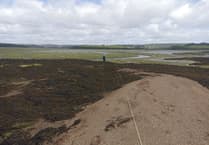Planting trees to absorb carbon is favoured by some politicians as a solution to climate change, and successive governments have pursued a tree-planting target of 30,000 ha of trees each year until 2050.
Trees store organic carbon in their wood for hundreds of years, made from the carbon dioxide (CO2) that the tree takes out of the air in photosynthesis. When the tree dies and decays, some carbon is released back into the atmosphere as CO2 and some becomes soil carbon.
Soil carbon from plants and trees trapped under sediment in the swampy conditions that dominated the Earth in the distant past, and marine animals that swam in ancient seas, formed fossil fuels. When we burn a fossil fuel, we are not burning the carbon taken in over a tree lifetime but that of billions of trees and animals over millions of years. This is why the trees in the world today cannot absorb as much carbon as we release from burning fossil fuels.
Put another way, humans have cut down 3 trillion trees – half of the trees on the planet. If we found a way of replanting all those 3 trillion trees, we would only remove the equivalent of three years of global greenhouse gas emissions.
If the government target is met, our tree cover would increase from 13% to 17%, which compares to an average of 30% across Europe. And if we stop burning fossil fuels, these trees will help to offset the remaining emissions that are difficult to eliminate, such as methane from livestock and making concrete.
For tree planting to be effective, the trees must survive. If they burn in a wildfire or are felled and burned for fuel, all the carbon will be lost again as CO2 in the air. A forest designed to store carbon must be protected permanently. After all, fossil fuels, buried far beneath layers of rock, have held onto their carbon for 300 million years or more.
The value of planting new trees in the UK is also lost if we burn trees from other parts of the world. The Drax power station, which receives green subsidies, releases 12 million tonnes of carbon a year, making it the country’s largest single source of carbon emissions. In 2023 alone, it is reported to have burnt more than 40,000 tonnes of wood from mature, native forests in British Columbia.
There are many good reasons for planting trees – for wildlife, for protecting our soils from erosion, especially on exposed uplands, and preventing flooding in our river catchments. A mix of native trees captures more carbon in the long term than commercial tree plantations. They need to be planted in the right place to avoid damaging other valuable habitats for wildlife. This can be outside woodland, such as hedgerow trees, shelterbelts, and trees within pastureland.
Politicians should know, however, that trying to offset carbon emissions by planting trees alone won’t work. We should never accept tree planting as an excuse to carry on burning fossil fuels.





Comments
This article has no comments yet. Be the first to leave a comment.